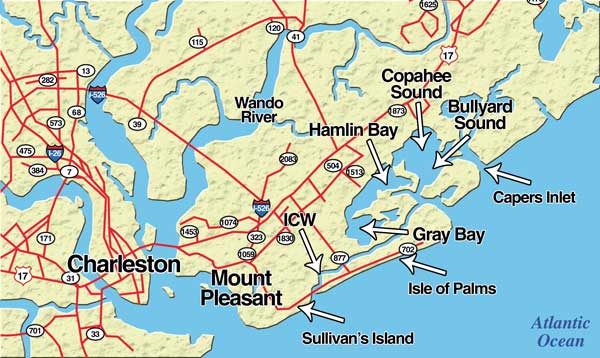
Late winter brings sparkling, clear water to the tidal marshes around Charleston, which creates opportunities and challenges for redfish anglers.
It starts out looking like a dark, nondescript mass, sort of like a grass bed or maybe a broad bottom indention.
As anglers peer into the water, though, the mass begins to pick up definition as fish — lots and lots and lots of fish — and that’s when JR. Waits’ clients tend to get excited.
Waits, who operates Fish Call Charters (843-509-7337) out of Isle of Palms and has fished around Charleston all his life, will work calmly from his poling platform, maneuvering the boat slowly into casting position and coaching clients as they make their casts.
If excitement doesn’t get the best of them, and they’re able to place baits in the right area before any fish detect the boat, it usually isn’t long before someone is hooked up with a Charleston red drum.
Waits fishes year-round, often with red drum — redfish, or spot tails, if you like —as his primary target, but winter is his favorite season.
“When the water temperature gets down to around 60 or even into the 50s, it really gets clear, and the fish school up on the flats,” he said. “One reason we like winter fishing is that we get to pole very quietly over the flats and to truly sight-cast to the fish. The water’s too murky to do that at other times.”
The schooling behavior has to do with the fish’s lowered body temperatures and slower movements, according to Mike Denson, an associate marine scientist for the Marine Resources Research Institute, which is part of the S.C. Department of Natural Resources.
“You can often find big schools of 2- to 5-year-old fish during the winter as the animals aggregate then along mud flats and oyster bars,” he said.
The colder the water turns, the bigger and tighter the schools tend to become. Biologists believe the schooling occurs both for the sake of the energy saved when all the fish move together in the water and for the sake of protection from porpoises, which think red drum are candy. Eight hundred eyes are better than two when it comes to spotting potential threats.
There’s no great rhyme or reason as to just where the fish will be, except that they like expansive, shallow flats. They aren’t feeding much, so tidal rips, creek mouths and other feeding lanes that hold fish at other times offer no great value. Instead, the schools just sort of cruise, moving up and down with the tides.
Waits does most of his winter searching and fishing either in the Intracoastal Waterway or in broad, open areas like Gray’s Sound (also called Gray Bay) and Copahee Sound.
“Something that’s nice is that most of the best flats are within 10 minutes of Isle of Palms Marina, so there are no long boat rides on cold mornings,” he said.
On low tide, Waits might look for schools along the edges of the Intracoastal Waterway or over low spots on the flats. As the tide rises, he’ll focus on the bays. He stays perched on his poling platform as much as possible, both for boat control and to give himself the best angle for peering down into the water.
“I used to always say that I liked low tide best because the fish had less places to hide,” Waits said. “These fish get pressured a bit more now, though, and they are spookier on low tide, so I’d rather have a little more water, not high tide — when they can get on top of the marsh and hide in the grass — but on the way up or down.”
Waits fishes almost daily, and schools tend to use the same areas for several days. Therefore, he typically knows general areas where he can look for schools. As much as is possible, he’ll fish different schools from one day to the next. “When the same schools get hit day after day, the fish become very wary, and they can become really difficult to catch,” he said.
When Waits spots a school of redfish, he approaches slowly and cautions everyone aboard to minimize boat noise and abrupt movements. If one fish gets spooked, the entire school often will turn tail and run. Waits stays as far back from the school as possible, poling his flats boat just close enough to allow his clients to manage accurate casts. If the school is moving in his direction — an ideal scenario — he’ll drop the Power-Pole to keep his boat from drifting and will watch and wait for the fish.
He coaches clients to never cast into the middle of the school, which will almost always spook the fish, but to cast past the fish and swim the bait back among them, or, better yet, to see which direction the fish are moving and lead the school or a particular fish with the cast.
“There’s nothing like picking out an individual fish, casting to that fish, seeing the strike and watching the entire fight in a foot of water,” he said.
Waits does the bulk of his winter fishing with Gulp! Jerk Shads, which he rigs on Gamakatsu weighted hooks. “Rigged that way, the Jerk Shad will fall horizontally, with the tail just sort of fluttering, and that seems to work well,” he said.
Waits generally tries to match the color of the water with his baits, sticking mostly with shades of green. If the water is off-colored from wind, he’ll turn to shades of brown, white or bright colors. Other baits that Waits sometimes turns to during the winter include a 3-inch Gulp! Shrimp, a Johnson spoon and a Zara Spook. He uses the spoon on windy days, because its vibrations help the fish find the bait. He likes the Spook, which he’ll walk slowly and steadily, because he can make long, accurate casts.
Although redfish schools cruise slowly about during the winter, they do so to conserve energy, not because they are unable to make hard, fast runs — and that becomes evident any time a fish gets on the line. They don’t have the quite same jet-engine speed or freight-train power as they do during the warmer months, but they still pack plenty of steam to challenge anglers and their tackle.
Waits spools 14-pound test line onto spinning reels, which he matches with 7-foot medium heavy rods. He likes high-visibility line so he can better track where baits are and watch for strikes, but he adds a section of clear leader to the end of his line.
Most fish caught in the marshes around Charleston will be in the 5- to 10-pound range, and prevalent sizes will vary a bit from year to year based on the strength of different year-classes.
“It appears that we often have one or two good year-classes followed by three or four poor year-classes,” Denson said. “Red drum stay in the estuary until they are four or five before becoming adults and moving to the outer beaches and offshore. That’s why you often see a few good years of fishing when a strong year-class comes through.”
Good and bad year-classes appear to be consistent in estuaries all along the South Carolina coast and are usually associated with weather patterns. The current population within the estuaries looks good.
“In South Carolina, specifically, we have seen strong year-classes in recent years,” Denson said.
The South Carolina limit for red drum in state waters is three fish daily, with a 15-inch minimum size and a 23-inch maximum. There is no closed season for rod-and-reel fishing.


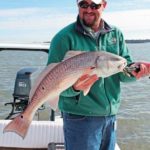
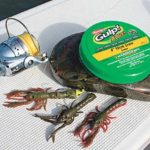
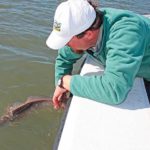

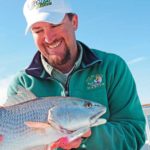
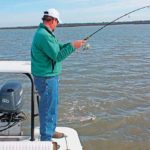


Be the first to comment